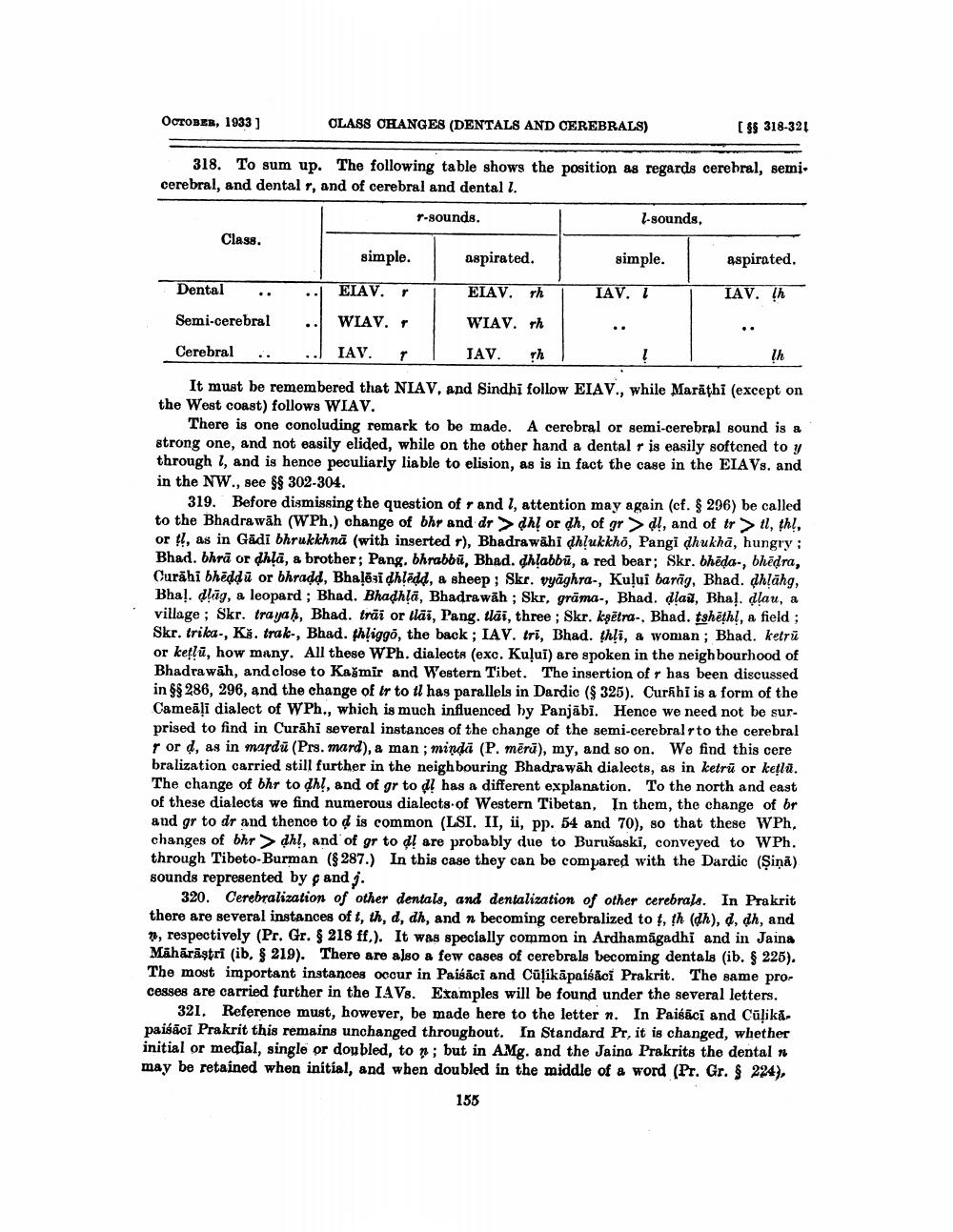________________
OCTOBER, 1933]
CLASS CHANGES (DENTALS AND CEREBRALS)
318. To sum up. The following table shows the position as regards cerebral, semi. cerebral, and dental r, and of cerebral and dental l.
r-sounds.
Class.
l-sounds,
simple.
aspirated.
Dental
ELAV. r
EIAV. rh
Semi-cerebral
WIAV. r
WIAV. rh
Cerebral
IAV. T
JAV.
Th
!
Th
It must be remembered that NIAV, and Sindhi follow EIAV., while Marathi (except on the West coast) follows WIAV.
simple.
[§§ 318-321
IAV. I
aspirated.
IAV. th
There is one concluding remark to be made. A cerebral or semi-cerebral sound is a strong one, and not easily elided, while on the other hand a dental r is easily softened to y through 1, and is hence peculiarly liable to elision, as is in fact the case in the EIAVs. and in the NW., see §§ 302-304.
319. Before dismissing the question of r and 1, attention may again (cf. § 296) be called to the Bhadrawāh (WPh.) change of bhr and dr> dhl or dh, of gr> dl, and of tr> tl, thị, or t, as in Gadi bhrukkhna (with inserted r), Bhadrawāhi dhlukkho, Pangi dhukhā, hungry; Bhad. bhrā or dhla, a brother; Pang, bhrabbu, Bhad. dhlabbu, a red bear; Skr. bheda-, bhedra, Curahi bheddu or bhradd, Bhalesi dhledd, a sheep; Skr. vyaghra-, Kului barng, Bhad. dhlahg, Bhal. dlug, a leopard; Bhad. Bhadhla, Bhadrawäh; Skr, grāma-, Bhad. dlau, Bhal. dlau, a village; Skr. trayaḥ, Bhad. trai or llai, Pang. tlai, three; Skr. ksētra-, Bhad. tsheth!, a field; Skr. trika-, Ks. trak-, Bhad. thliggo, the back; IAV. tri, Bhad. thli, a woman; Bhad. ketrū or keṭlu, how many. All these WPh. dialects (exc. Kului) are spoken in the neighbourhood of Bhadrawah, and close to Kašmir and Western Tibet. The insertion of r has been discussed in §§ 286, 296, and the change of ir to tl has parallels in Dardic (§ 325). Curahi is a form of the Cameāli dialect of WPh., which is much influenced by Panjabi. Hence we need not be surprised to find in Curahi several instances of the change of the semi-cerebral r to the cerebral r or d, as in mardu (Prs. mard), a man; minda (P. mērā), my, and so on. We find this cere bralization carried still further in the neighbouring Bhadrawah dialects, as in ketru or keṭlü. The change of bhr to dhl, and of gr to dl has a different explanation. To the north and east of these dialects we find numerous dialects of Western Tibetan, In them, the change of br and gr to dr and thence to d is common (LSI. II, ii, pp. 54 and 70), so that these WPh. changes of bhr> dhl, and of gr to dl are probably due to Burušaski, conveyed to WPh. through Tibeto-Burman (§ 287.) In this case they can be compared with the Dardic (Şiņā) sounds represented by and j.
320. Cerebralization of other dentals, and dentalization of other cerebrals. In Prakrit there are several instances of t, th, d, dh, and n becoming cerebralized to t, th (dh), d, dh, and , respectively (Pr. Gr. § 218 ff.). It was specially common in Ardhamagadhi and in Jaina Mähäräştri (ib, § 219). There are also a few cases of cerebrals becoming dentals (ib. § 225). The most important instances occur in Paisaci and Culikäpaiśāci Prakrit. The same processes are carried further in the IAVs. Examples will be found under the several letters.
321. Reference must, however, be made here to the letter n. In Paisaci and Culikā. paisaci Prakrit this remains unchanged throughout. In Standard Pr, it is changed, whether initial or medial, single or doubled, to n; but in AMg. and the Jaina Prakrits the dental n may be retained when initial, and when doubled in the middle of a word (Pr. Gr. § 224),
155




